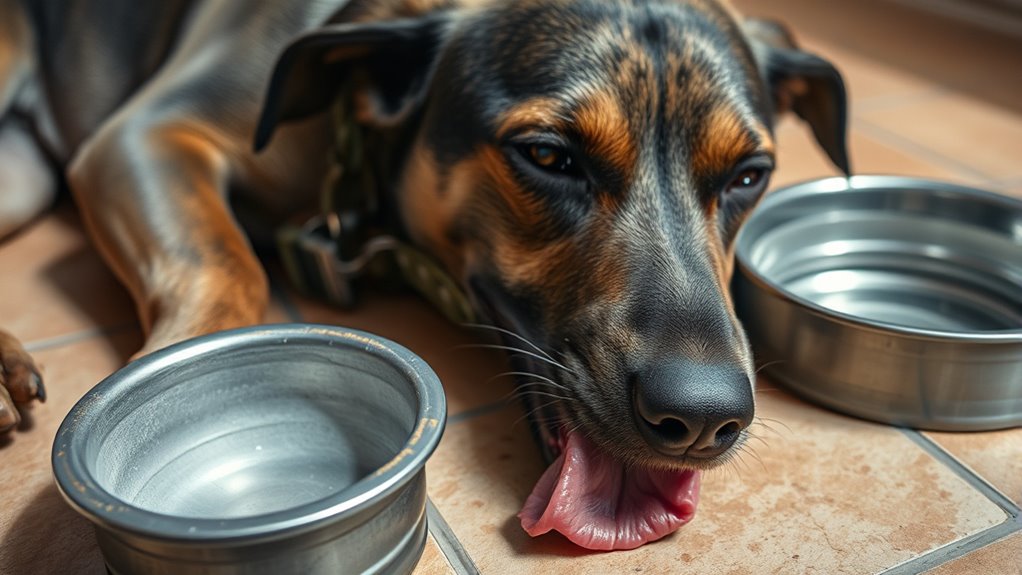If your dog shows signs of dehydration, watch for excessive thirst, dry mouth, and sticky saliva. Notice if they become less active, lethargic, or have sunken eyes and dry gums. Check their skin elasticity by gently pinching the skin—if it stays tented, it’s a concern. Dark urine, dry nasal passages, and rapid breathing are also warning signs. Staying alert helps protect your dog’s health, and there’s more you can do to keep them safe.
Key Takeaways
- Excessive thirst, dry mouth, and dry gums indicate dehydration in dogs.
- Loss of skin elasticity, such as skin tenting, signals dehydration.
- Lethargy, reduced activity, and panting are behavioral signs of dehydration.
- Sunken eyes, dry gums, and dark urine are physical indicators of dehydration.
- Nasal discharge, crusting, and sticky saliva suggest hydration issues in dogs.
Excessive Thirst and Dry Mouth
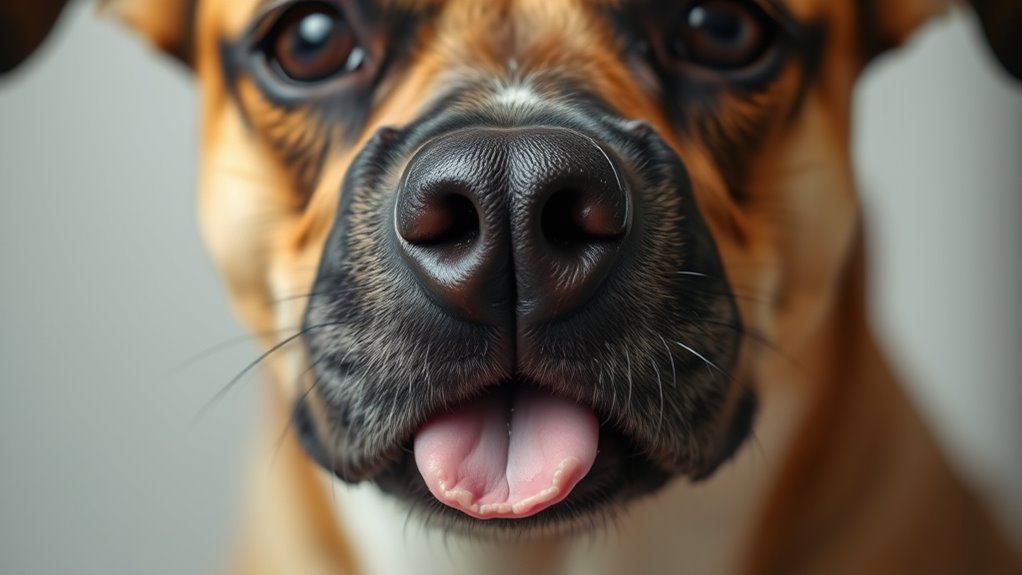
When your dog starts drinking water more frequently than usual, it’s often a sign of dehydration. Pay attention to their increased water intake and dry mouth, which are key hydration tips to watch for. If your dog seems to constantly lick their lips or has a noticeably dry gum line, these are signs they need more fluids. Make certain they always have access to fresh, clean water to prevent dehydration from worsening. You might also consider adding water-rich foods like wet dog food or ice cubes to their diet. Monitoring their water consumption helps you catch dehydration early, so act quickly if you notice these signs. Proper hydration is essential for your dog’s health, so stay vigilant and encourage regular water intake. Some pet owners find that self watering water bowls can help maintain consistent hydration levels in their pets.
Reduced Energy and Lethargy
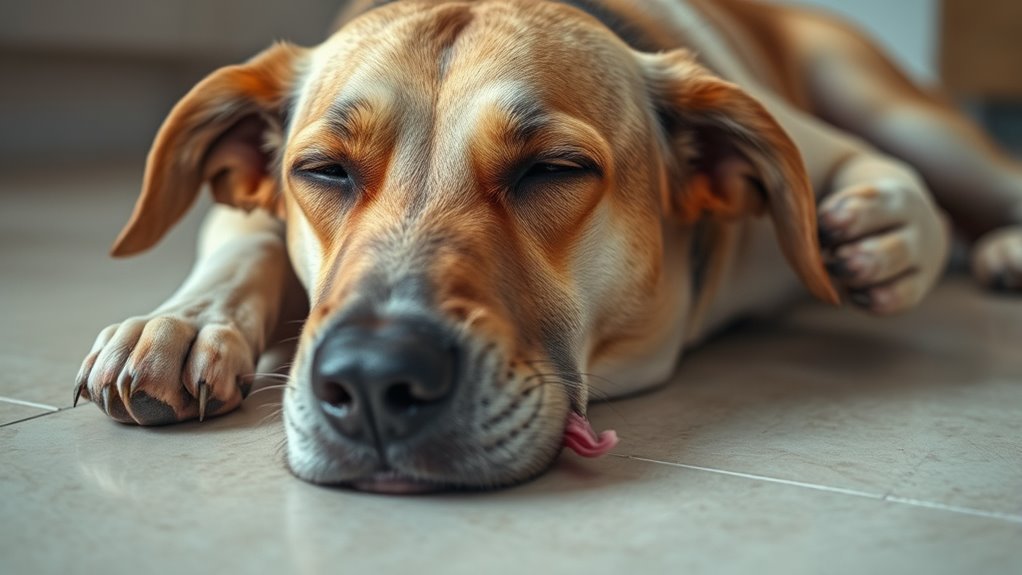
A noticeable drop in your dog’s activity level or persistent tiredness can be be a warning sign of dehydration. When your dog seems sluggish or avoids normal play, it’s crucial to monitor their hydration. To help, focus on hydration tips like encouraging regular water intake throughout the day. Make sure fresh water is always available, and consider adding water to their food if they’re not drinking enough. Dehydration reduces energy levels, so don’t dismiss lethargy as just laziness. Keep an eye on how your dog responds to activity and ensure they stay well-hydrated. If their energy doesn’t improve with increased water intake, consult your vet promptly. Proper hydration supports your dog’s vitality and helps prevent dehydration’s serious health consequences. Retail store hours can sometimes affect access to supplies needed for your pet’s hydration and care. Additionally, understanding signs of dehydration can help you identify issues early and seek appropriate treatment.
Sunken Eyes and Dry Gums
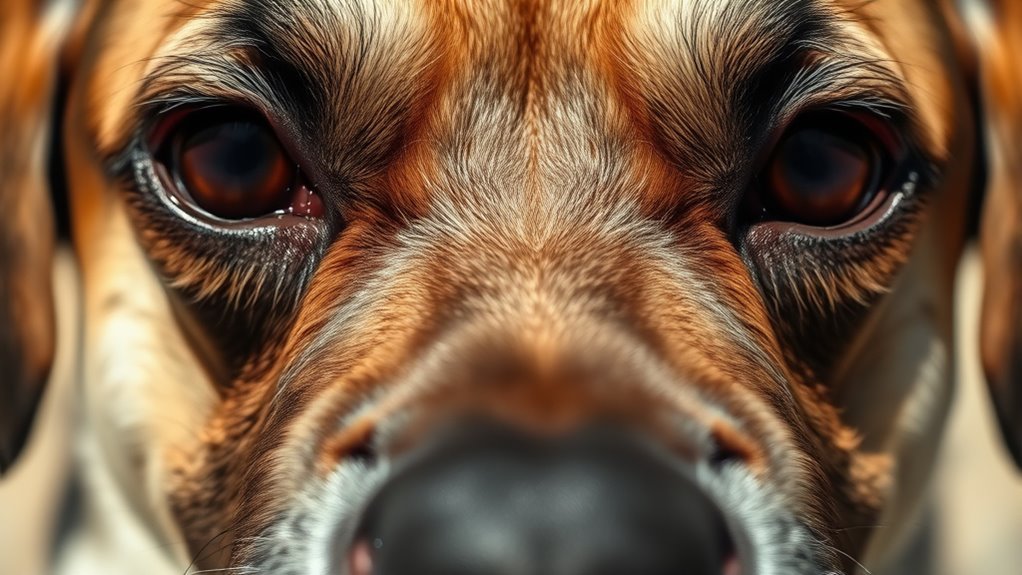
Sunken eyes and dry gums are clear signs that your dog may be dehydrated. When you notice these symptoms, it’s essential to act quickly. Check your dog’s water intake and encourage them to drink more, offering fresh, clean water regularly. Hydration tips include providing multiple water bowls around your home and adding water to their food if they’re eating dry kibble. You can also try flavoring the water with a bit of low-sodium broth to entice them to drink. Persistent dehydration signs like sunken eyes and dry gums need immediate attention to prevent further health issues. Keep a close eye on your dog’s hydration levels, especially during hot weather or after exercise, to ensure they stay properly hydrated and healthy. Additionally, utilizing AI-driven insights can help monitor your pet’s health more effectively. Recognizing dehydration signs early can prevent serious complications and support your dog’s overall well-being. Advances in machine learning technology are making it easier for pet owners to track health indicators and respond promptly, especially with home monitoring devices that can alert you to changes in your dog’s condition.
Loss of Skin Elasticity
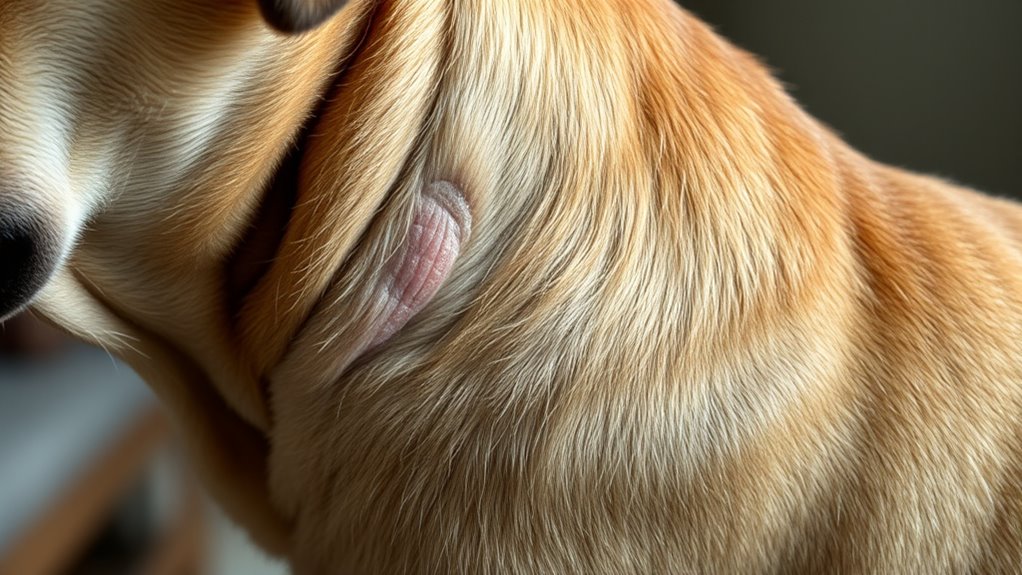
Loss of skin elasticity is a noticeable sign that your dog may be dehydrated. When you gently pinch the skin between their shoulders or on the back, it should quickly snap back into place. If it remains tented or slowly returns, dehydration could be the cause. To support your dog’s skin health and hydration, consider these hydration tips: always provide fresh water, add moisture-rich foods like wet dog food, and encourage frequent drinking during hot weather. Maintaining good skin elasticity helps prevent infections and keeps your dog comfortable. Proper hydration not only improves skin health but also supports overall well-being, making it easier to spot early signs of dehydration. Additionally, HEPA filtration can help reduce airborne allergens that may contribute to skin irritations or allergies in dogs.
Dark or Discolored Urine
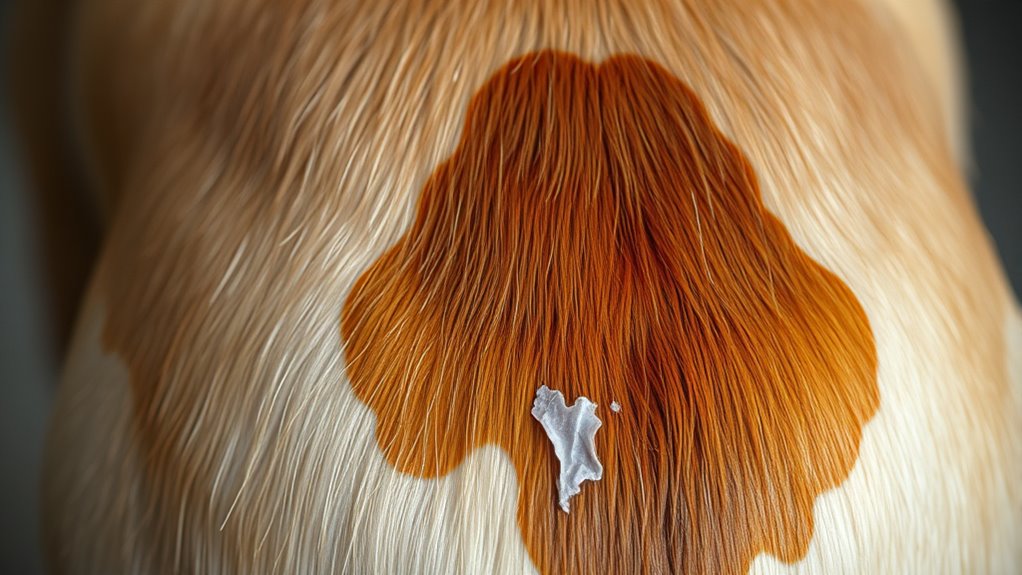
Dark or discolored urine in your dog can be a clear sign of dehydration or other health issues. If you notice urine that’s darker than usual, it’s time to pay attention and consider hydration tips to encourage fluid intake. Urine color varies depending on hydration levels—pale yellow indicates proper hydration, while dark urine suggests dehydration. To help your dog stay well-hydrated, ensure fresh water is always available and consider adding water or broth to their food. Keep an eye on changes in urine color, especially if it persists or worsens. Prompt action can prevent complications, so if your dog’s urine remains dark despite hydration efforts, consult your veterinarian for further evaluation and care. Maintaining proper hydration is crucial for overall health and can be supported by understanding air quality benefits, which include reducing airborne pathogens and promoting a healthier environment for your pet. Additionally, proper hydration supports kidney function and overall vitality. Remember that environmental factors like seasonal changes can also influence hydration needs and urine health.
Dry or Sticky Nasal Passages

You may notice your dog’s nose feels dry or sticky, which can be a sign of dehydration. Look for signs like crusting around the nostrils or unusual nasal discharge. These symptoms shouldn’t be ignored and warrant a closer look. Monitoring hydration levels regularly can help ensure your dog stays healthy and well-hydrated. Additionally, understanding signs of dehydration can aid in early detection and prompt treatment. Maintaining proper hydration is essential, as dehydration can also impact your dog’s overall respiratory health, making it even more important to watch for these symptoms.
Dryness and Crusting
Dry or sticky nasal passages are common signs that your dog may be dehydrated. When your dog’s nose feels crusty or cracked, it can also lead to skin irritation around the snout, making them uncomfortable. The dryness might cause eye discomfort as well, since dehydration affects moisture levels in their eyes and skin. Pay attention to these signs, as they can indicate that your dog needs hydration.
- Crusting around the nose can worsen, leading to further skin irritation
- Increased eye discomfort may cause scratching or pawing at their eyes
- Skin irritation from dryness can develop into infections if not addressed
- Persistent crusting and dryness could signal underlying health issues needing vet attention
- Recognizing dehydration symptoms early can help prevent more serious health problems.
- Dehydration can also affect electrolyte balance, which is vital for overall health and muscle function.
Additionally, dehydration can impair skin elasticity, making your dog more prone to additional skin issues.
Unusual Nasal Discharge
Unusual nasal discharge, such as dry or sticky nasal passages, often indicates dehydration in dogs. You might notice thick or crusty nasal mucus that doesn’t clear easily, which can be a sign of dehydration affecting your dog’s mucous membranes. Respiratory signs, like difficulty breathing or sneezing, may accompany this nasal discharge, signaling that your dog isn’t getting enough fluids. A dry or sticky nose isn’t just a trivial issue—it can reflect underlying dehydration that impacts overall health. Keep an eye on your dog’s nasal condition, especially if the discharge persists or worsens. Dehydration symptoms can sometimes be mistaken for other health issues, so consulting a veterinarian is recommended if concerns arise. Proper hydration supports nasal moisture and overall respiratory health, making early intervention important. Recognizing these signs early helps prevent respiratory complications and ensures your dog remains comfortable and healthy. Staying aware of changes in your dog’s nasal condition can help catch dehydration early and prevent further complications.
Thick Saliva and Sticky Mouth

You might notice your dog producing excess saliva or having a thick, sticky mouth. Wiping their lips becomes difficult as residue clings stubbornly, indicating possible dehydration. Keep an eye out for these signs, and act quickly if they persist. Using proper hydration techniques can help prevent worsening symptoms.
Excess Saliva Production
Have you noticed your dog producing thick, sticky saliva or having a mouth that feels unusually tacky? Excess saliva production can signal dehydration or other health issues. Changes in saliva consistency often make it harder for your dog to swallow comfortably, while saliva color may become pale or discolored.
- Saliva consistency becomes thicker, indicating dehydration.
- Saliva color may shift to pale or discolored, signaling underlying problems.
- Excessive saliva can cause drooling and discomfort.
- This symptom may accompany other signs like lethargy or dry gums.
- Monitoring these signs helps you recognize dehydration early. Proper hydration is essential for maintaining your dog’s overall health and preventing complications. Dehydration can also affect organ function and lead to serious health concerns if left untreated. Keep an eye out for changes in your dog’s mouth and overall behavior, and consult your vet if symptoms persist. Additionally, understanding key domains of development in psychology can help owners recognize behavioral changes that may indicate health issues.
Difficulty Wiping Mouth
When your dog has thick, sticky saliva that’s difficult to wipe away, it often indicates dehydration or oral discomfort. You might notice that wiping their mouth doesn’t remove the saliva easily, which can be a sign of saliva changes caused by dehydration. Mouth discomfort may also cause your dog to paw at their mouth or become less willing to eat or drink. These saliva changes can make their mouth feel sticky and hard to clean. If you observe this, it’s important to assess other dehydration signs and encourage water intake. Persistent difficulty wiping the mouth could indicate a more serious issue, so consult your veterinarian promptly to ensure your dog stays properly hydrated and comfortable.
Persistent Sticky Residue
Thick, sticky saliva that clings to your dog’s mouth and paws is a clear sign of dehydration. When your dog’s mouth feels tacky or coated with a sticky residue, it indicates they’re losing essential fluids. This persistent sticky residue can make it difficult for your dog to eat or drink comfortably. To prevent dehydration, focus on hydration tips like providing fresh water regularly and encouraging your dog to drink. Monitor their saliva consistency and look for signs of discomfort.
- Ensure constant access to clean water
- Use flavor enhancers to make drinking appealing
- Offer ice cubes or wet food for extra hydration
- Observe their behavior for other dehydration signs
Implementing these dehydration prevention measures helps keep your dog healthy and hydrated. Recognizing sticky saliva early can make all the difference.
Panting and Rapid Breathing
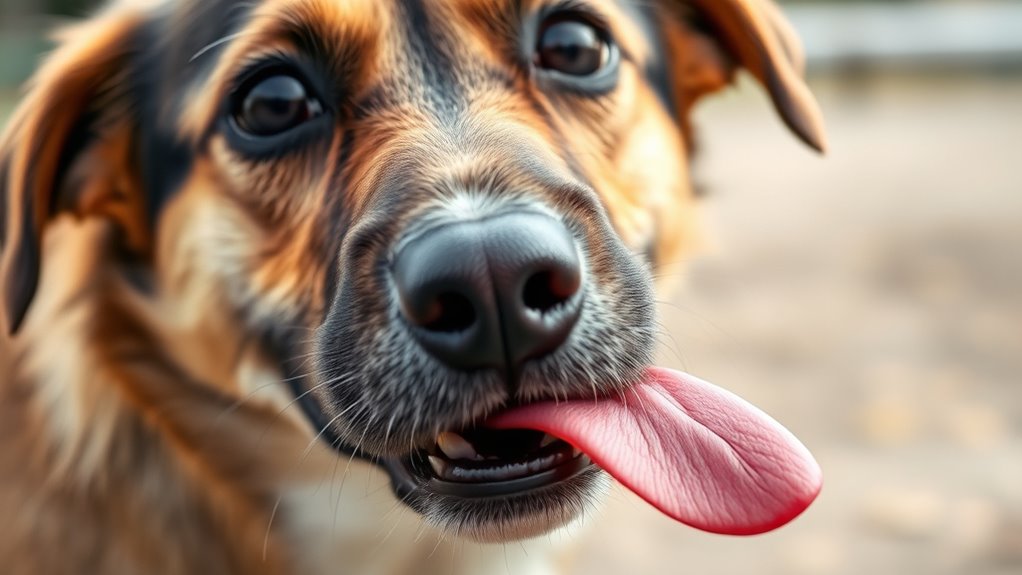
Panting and rapid breathing are common signs that your dog may be dehydrated, especially after vigorous activity or exposure to heat. When you notice these symptoms, it’s vital to recognize thirst triggers and respond quickly. To help your dog stay hydrated, implement hydration strategies such as offering fresh water frequently and providing shade during walks. Rapid breathing can also signal that your dog is trying to cool down or that their body is struggling to maintain fluid balance. Keep an eye on their behavior and make sure they have access to clean water at all times. Address dehydration promptly by encouraging drinking and, if symptoms worsen, consult your veterinarian to prevent more serious health issues.
Frequently Asked Questions
How Long Can a Dog Survive Without Water Before Serious Health Issues Occur?
You might wonder how long your dog can go without water before it’s risky. Typically, a dog can survive about 3 to 5 days without water, but this depends on their size, health, and environment. During this hydration duration, your dog risks dehydration, which can cause serious health issues. Guarantee your dog has consistent water intake, especially in hot weather, to prevent dehydration and keep them healthy.
Are Certain Dog Breeds More Prone to Dehydration?
You might think all dogs are created equal, but some breeds have higher susceptibility to dehydration due to their unique characteristics. Breeds with thick coats, like Bulldogs or Brachycephalic breeds, often have greater hydration needs and can overheat quickly. Smaller or active breeds also lose fluids faster, making them more prone to dehydration. Knowing your dog’s breed susceptibility helps you monitor hydration needs and prevent health issues before they escalate.
Can Dehydration Symptoms in Dogs Be Mistaken for Other Illnesses?
You might mistake dehydration symptoms in dogs for other illnesses because of symptom overlap, making differential diagnosis essential. Signs like lethargy, dry gums, and loss of skin elasticity can resemble symptoms of infections or other health issues. To accurately identify dehydration, observe for specific signs and consult your vet. They can perform tests to distinguish dehydration from other conditions, ensuring your dog receives proper treatment promptly.
What Are the Immediate Steps to Take if My Dog Shows Dehydration Signs?
If your dog displays dehydration signs, act swiftly. Start with emergency hydration—offer water or electrolyte solutions, but don’t force too much at once. Keep your pup calm and comfortable. Next, prioritize prompt veterinary consultation; a professional can diagnose and deliver definitive treatment. Remember, immediate intervention can prevent serious health issues, so don’t delay seeking expert advice and care. Your quick response can make a vital difference in your dog’s well-being.
How Can I Prevent Dehydration in My Dog During Hot Weather?
To prevent dehydration in your dog during hot weather, you should follow hydration tips like providing plenty of fresh water and encouraging regular drinking. Use cooling methods such as shaded areas, fans, or cooling mats to keep your pet comfortable. Keep walks early in the morning or late evening, and avoid intense exercise during peak heat. These steps help maintain hydration and keep your dog safe and cool.
Conclusion
Keep a close eye on your dog’s signs—dry mouth, sunken eyes, or a lack of energy. Imagine their once vibrant tail wagging slowly, their bright eyes dulled by dehydration. By noticing these warning signs early, you can provide fresh water and comfort, preventing their body from drying out like a wilted flower. Stay attentive, and your furry friend will bounce back, full of life and joy once more.

